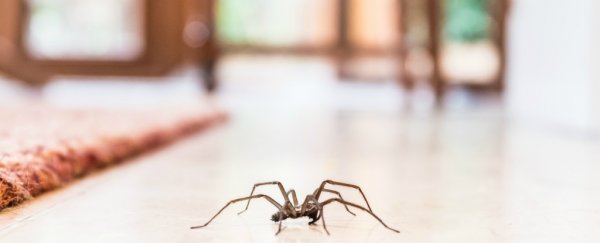You're at home, making your dinner and suddenly you see an eight legged intruder waltzing around your kitchen.
Although it probably won't be much comfort in the moment, your spider encounter is extremely typical, according to a new study out of the UK.
The researchers, from the University of Gloucestershire and the Charles Darwin House created a free app called 'Spider in da House' (lol) back in August 2013 for the general population to track any run ins with spiders.
The team encouraged UK participants to fill in records about their eight legged encounters up until January 2014, and the team ended up with 9,905 records across the UK.
"Participants recorded: date; time; latitude/longitude (automatically derived for app users with location services enabled); room (e.g. bedroom, kitchen, bathroom); location within room (e.g. ceiling, wall, on furniture); and sex of spider (female, male, or unsure)," the researchers write in their paper.
And what the researchers found from this data set was fascinating. First of all, the vast majority (82 percent) of spiders walking around homes in the UK were male.
"The overall sex ratio was highly male biased confirming the finding of other studies that the peak in spider sightings is driven by males searching for mates," the researchers explain.
So the spiders you're seeing around your home are probably randy males wanting to make more spider babies.
"The females can be seen on webs in garages and windowsills, while the males wander around looking for chances to mate," explains one of the researchers Adam Hart to The Telegraph.
"And of course our houses are nice places for them to come and do that."
The most likely time to see a spider was in the evenings, between 6 pm and 9 pm, and the mean average was 7.35 pm.
But as the researchers explain, that is not necessarily when spiders are out the most, just the time when we're most likely to see them.
"Those participants that work outside the home during normal daytime working hours are unable to record sightings during the day and are far more likely to record sightings in the early evening," write the researchers.
"Thus, the mean evening time of sightings could simply reflect the behaviour of people and we cannot say the extent to which the absence of sightings during the daytime can be accounted for by the absence of people within homes to record sightings."
But what is coolest about this study is that using everyday people, known as citizen scientists researchers were able to gather wide and varied data about house spiders.
According to the researchers, the 10,000 records is 250 times more locations and 25 times more records than any previous UK spider study.
Hopefully this success could even lead to more information about the other types of creepy crawlies we share our houses with, and maybe create a little more tolerance to our eight legged house guests.
The research has been published in Arachnology.
